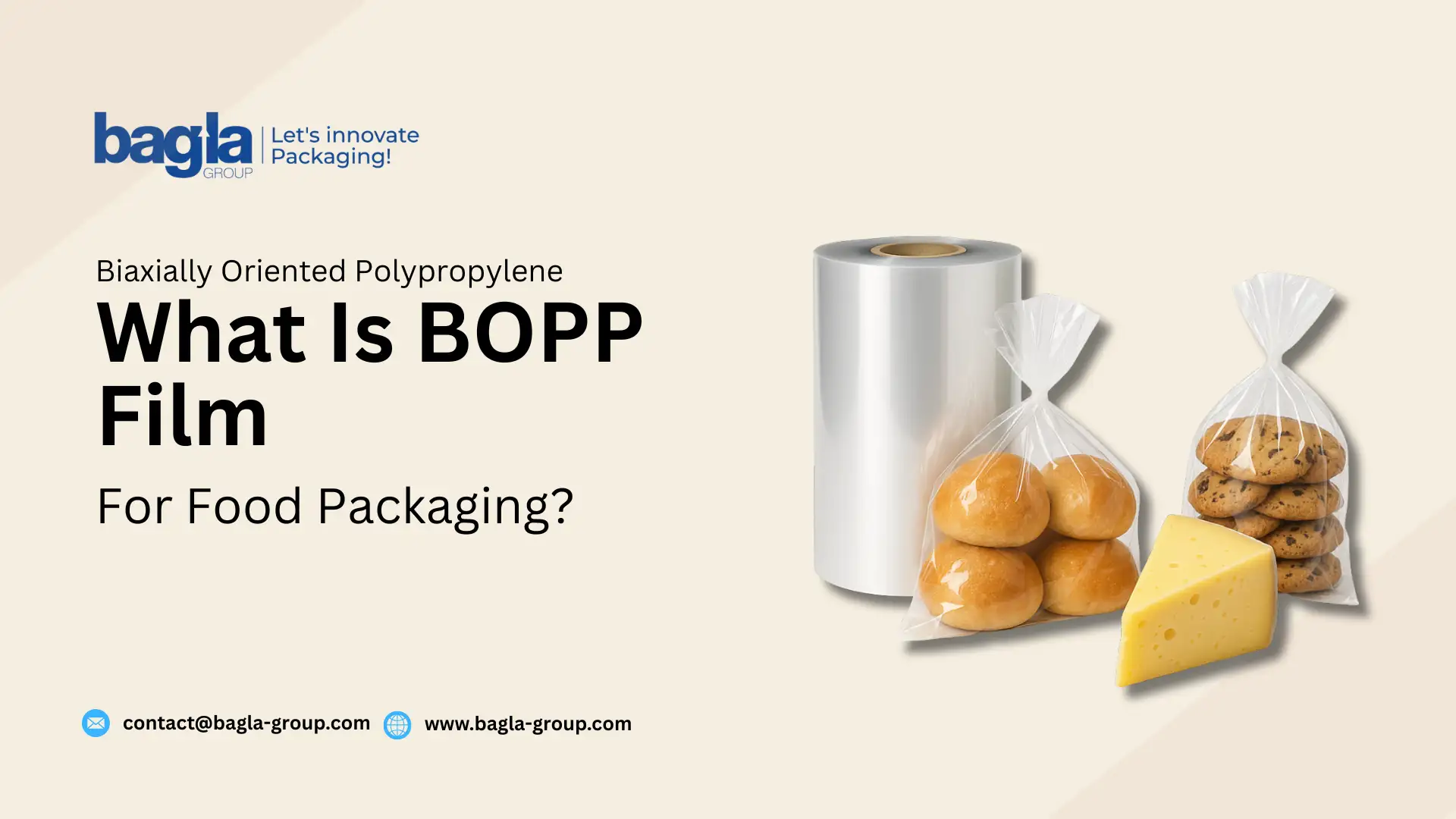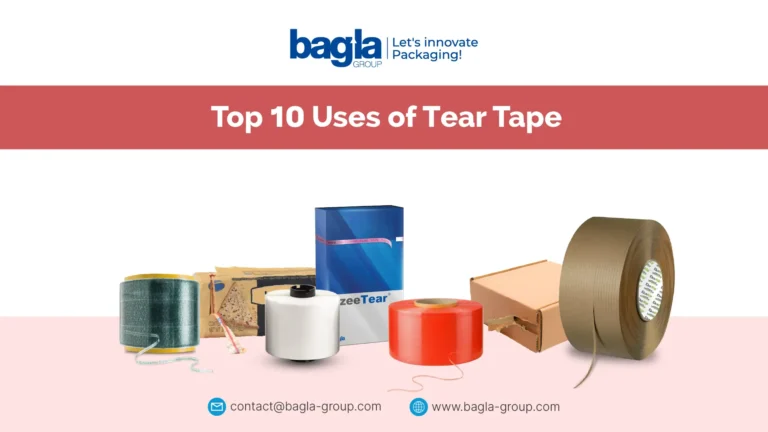When you unwrap your favourite packet food, such as chips, biscuits, etc., you will find a shiny cereal pouch. There is are great chances that you are interacting with BOPP film. It is one of the reliable and unsung heroes of the food packaging world. So, let’s understand these BOPP films and why they are so widely used in the market.
So, whether you are a business owner,
Whether you’re a business owner, packaging enthusiast, or just a curious foodie, this blog will unpack everything you need to know about BOPP film in food packaging, from how it’s made to why brands across the globe swear by it.
What is BOPP?
BOPP stands for Biaxially Oriented Polypropylene. It is a type of polypropylene film that has been stretched in machine direction (MD) and transverse direction (TD). This biaxial orientation significantly enhances the film’s mechanical, optical, and barrier properties, making it ideal for food packaging applications.
The film is created by extruding a sheet of polypropylene polymer, which is then stretched biaxially at elevated temperatures. This stretching aligns the polymer molecules in both directions, improving strength, clarity, and resistance to water and vapor.
How is BOPP Film Made?
The process of making BOPP film is pretty fascinating:
- Resin pellets (polypropylene) are melted and formed into a thin sheet.
- The sheet is then stretched – first in one direction (machine direction), then in the other (transverse direction).
- After stretching, it’s heat-treated to lock in its new structure.
- Finally, it’s cooled, slit, and rolled into massive reels, ready to be printed or laminated.
Key Features Of BOPP Films
The BOPP films have multiple features that make these films more valuable than are hard-to-beat counterparts:
- High Clarity – This is perfect for food products to check the freshness through packaging.
- Glossy or Matte Finish – BOPP films make products visually attractive for buyers.
- Strong and Tear-Resistant – If you are transporting your products then it is great for handling and transport.
- Moisture Resistant – Keeps contents fresh and crispy by resisting moisture.
- Odor-Free and Non-Toxic – Ideal for direct food contact to increase the shelf life.
- Lightweight – Reduces shipping and production costs of the packaging.
- Recyclable – A big plus in the age of sustainable packaging
Different Types of BOPP Films in Food Packaging
Depending on your packaging goals, there’s a BOPP film that fits perfectly:
- Plain BOPP Film – Basic and uncoated, often used in laminates.
- Heat Sealable BOPP Film – Ideal for pouches and flow wraps, seals easily with heat.
- Metalized BOPP Film – Adds a shiny, foil-like barrier, commonly used in snacks and dry foods.
- Pearlized BOPP Film – Opaque white with a pearly finish, great for confectionery.
- Matte BOPP Film – Offers a premium, soft-touch finish, used in gourmet and luxury packaging.
- Anti-Fog BOPP Film – Prevents condensation, perfect for refrigerated foods.
Shrink Film Vs BOPP Shrink Films
If you think that the shrink films and BOPP films are the same, then let us provide you with a comparison of these to compare it
| Shrink Films | BOPP Films |
| It shrinks when heat is applied, creating a tight seal around the product. | It does not shrink, but has high tensile strength and superior clarity, making it suitable for overwrap applications. |
| It is cheaper to produce than BOPP film, making it more cost-effective for some applications. | It is more expensive to produce than shrink film, but can save costs in the long run by reducing package damage. |
| If you are concerned about the environment, then you must shift to BOPP films. Otherwise, Bagla Group offers recyclable POF Shrink Films. | It is more recyclable than shrink film, but not biodegradable. However, biodegradable versions are being developed. |
Where Do You See BOPP in Food Packaging?
Just about everywhere! Here are some everyday food items that rely on BOPP films:
- Chips, popcorn, and other snacks
- Biscuits, cookies, and cakes
- Chocolate bars and candy
- Dry foods like rice, pasta, and flour
- Tea, coffee, and spices
- Frozen foods and refrigerated items
- Ready-to-eat meals and instant noodles
Printability and Branding
One of the biggest wins with BOPP is how beautifully it can be printed.
With the right surface treatment (like corona discharge), BOPP films become ideal for:
- Vibrant graphics and branding
- Nutritional information and labels
- Barcode and QR code printing
Whether you’re using gravure, flexographic, or digital printing, BOPP gives a smooth surface and excellent ink adhesion, which means more eye-catching packaging on store shelves.
Is BOPP Environmentally Friendly?
BOPP is considered one of the more eco-conscious plastic packaging materials:
- It’s fully recyclable (in polyolefin recycling streams)
- Uses less energy to produce than many alternatives
- Lightweight, reducing transportation emissions
- Available in mono-material options for better recyclability
Many packaging companies are now shifting to mono-layer BOPP structures that are easier to recycle, helping reduce the plastic footprint.
Safety and Food-Grade Compliance
If you’re wondering whether BOPP is safe for your food, the answer is a big YES.
BOPP films are:
- FDA-approved
- Compliant with EU food contact regulations
- Odorless and non-reactive
- Free from heavy metals and harmful additives
From wrapping a piece of cake to sealing fresh produce, BOPP ensures that food stays safe, uncontaminated, and fresh.
BOPP vs Other Films: How Does It Compare?
Here’s a quick comparison to help you understand where BOPP stands:
| Film Type | Strength | Clarity | Barrier | Recyclability | Cost |
| BOPP | High | High | Moisture: Good | Good | Low |
| PET | Higher | High | Oxygen: Excellent | Moderate | Medium |
| PE | Medium | Low | Excellent moisture | Excellent | Low |
| PVC | Medium | Moderate | Moderate | Poor | Medium |
Takeaway? BOPP is a strong all-rounder with great value for money.
Any Challenges with BOPP?
While BOPP is fantastic, no material is perfect. Some challenges include:
- Lower oxygen barrier than PET or EVOH
- Not microwave safe
- May need lamination for oily or wet products
- Can build up static electricity during production
Thankfully, most of these are solved using multi-layer laminates or coatings, depending on the product.
Future of BOPP in Food Packaging
The food packaging industry is constantly evolving, and BOPP is keeping pace. Here’s what’s next:
- Transparent high-barrier BOPP to replace foil
- Fully recyclable mono-material BOPP pouches
- Bio-based BOPP made from renewable sources
- Smart BOPP films with printed sensors or QR codes
- Advanced cold-seal and heat-seal tech for faster packaging
With innovation in materials and consumer demand for sustainable packaging, BOPP is set to stay a top contender.
Final Thoughts
BOPP is more than a plastic wrap. For most of the industries, it is a packaging powerhouse. Through this, consumers can simply add excellent clarity, strength, moisture resistance, and sustainability potential. BOPP is helping food brands strike the perfect balance between functionality, cost, and branding.
So the next time you unwrap your snack, give a little nod to the science behind the packaging – because chances are, it’s BOPP that’s keeping it fresh and fabulous.



